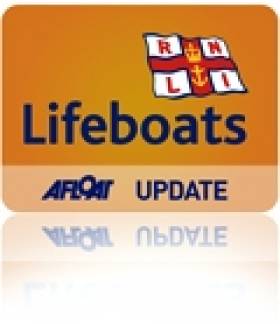Displaying items by tag: Ear to the Ground
Lough Swilly RNLI Featured On 'Ear to the Ground'
#RNLI - RTÉ’s popular agricultural programme Ear to the Ground paid a visit to Lough Swilly RNLI recently which will feature on this week's episode on Thursday evening.
Set to feature is local man Francis Burns, who along with running a successful farm hoof care business also volunteers with Lough Swilly RNLI’s lifeboat crew.
The programme, which looks at issues concerning agriculture and the rural community, had planned to spend a day with Burns carrying out his job – but when producers heard about his role as a volunteer lifeboat crew member, they decided to include his role with the RNLI too.
Burns and fellow Lough Swilly lifeboat volunteers Eamonn Mahon, Michael Doherty, Tommy Cooper and Francis Bourne showed their guests around the station and demonstrated a lifeboat launch for them.
While most visitors to the station are particularly interested in the RNLI’s Atlantic 85 inshore lifeboat, the Ear to the Ground crew were particularly impressed with the RNLI’s huge custom-built tractor, which the lifeboat crew uses to launch and recover the lifeboat.
The massive tyres are filled with water and antifreeze to make sure it stays on the ground when it enters the water.
Speaking about the filming, Burns said: “I’ve wanted to be a member of Lough Swilly RNLI ever since we got a day off school to come down and see the new all-weather lifeboat arriving at the station.
"Lifeboats are in my family as my cousin George O’Hagan is also the second coxswain on the lifeboat.
"It will be great to be able to show people how lifeboat volunteers can work in the agricultural sector and still be able to train and go out on the lifeboats to help rescue people.”
Programme director Liam Lavelle added: “We are delighted to be able to include the RNLI on Ear to the Ground. It’s a great story about people who volunteer to save lives.
"In our programme we try and reflect what people are doing in rural communities. Many of these communities touch the sea and this work is an important part of Francis’s story."
The programme is due to air on RTÉ One this Thursday evening 31 January at 8.30pm.
Bass Angling Feature on Tonight's 'Ear to the Ground'
#ON THE TV - Tonight's episode of Ear to the Ground on RTÉ One will feature a report on bass angling in Ireland, and the commercial fishing sector's efforts to re-open bass fisheries.
Among those interviewed for the feature were Dr Ed Fahy, who gave a talk at the recent Hook Bass Angling Festival discussing the threat to Ireland's sea bass should the fishery be opened to commercial interests, and argueing the case for bass angling tourism as a greater boon for the economy.
Ear to the Ground is broadcast tonight at 8.30pm on RTÉ One.






























































